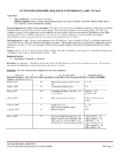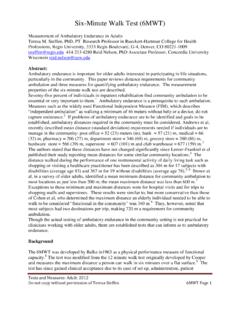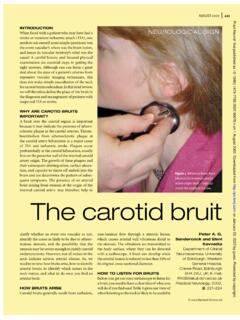Transcription of Dynamic Gait Index (DGI)/Functional Gait Assessment (FGA)
1 Dynamic Gait Index (DGI)/Functional Gait Assessment (FGA) Tests and Measures: Adult; 2012 DGI Page 1 Do not copy without permission of Teresa Steffen Dynamic GAIT Index (DGI)/FUNCTIONAL GAIT Assessment (FGA) Type of test: Time to administer: 15 minutes Clinical Comments: Familiarity with the ordinal scoring system prior to administering test as important, as scoring system varies among items. Standardized instructions seem cumbersome. Purpose/population for which tool was developed: The Dynamic Gait Index (DGI) was developed as part of a profile for predicting likelihood of falls in older adults. The tool was presented in 1993 as a way to assess and document a patient s ability to respond to changing task demands during , 2 The 8 items vary the walking task by changing walking speeds, adding head turning, turning and stopping, walking over and around obstacles, and ascending / descending stairs. Scoring focuses on changes in balance or changes in gait patterns during the various walking tasks.
2 A shortened DGI was developed based on Rasch analysis of level of item difficulty for 123 persons with diagnosed balance or vestibular problems. It contains 4 items: horizontal head turns, vertical head turns, gait on level surfaces, and changes in gait speed; the shortened version has equivalent or superior psychometric properties compared to the 8 item When appropriate to use: This tool has been used with older adults with a history of falls and imbalance, 1-5 patients with bilateral vestibular loss,6 patients with vestibular dysfunction with & without migraine headaches, 7-10 patients with chronic stroke,11 Parkinson Disease12 multiple sclerosis,13 and essential Scaling: Each of the 8 items is scored from 0 3, on an ordinal scale, with the best possible total equal to 24 and the worst score equal to zero. The Rasch measurement model, applied to data on 84 community-dwelling male veterans, showed that the 4-point rating scale appeared to distinctly identify subjects at different ability levels.
3 15 The 4 item version is scored 0--12. Equipment needed: Scoring form level walking area at least 20 feet in length stopwatch shoe box 2 cones (to serve as obstacles in walking pathway) stairs with railing Directions: Instructions for each item are included on the scoring form (attached). In 84 community dwelling male veterans, Rasch measurement model analysis showed that the most difficult items were gait with horizontal head turns , steps , and gait with vertical head turns ; the easiest items were gait on level surfaces , change in gait speed , and step around obstacles . Clinicians may want to consider changing the order of test administration (from easiest to most difficult) especially in clients with severe Reliability: Reference N = Sample Description Reliability Statistic Intrarater Reliability: same rater within one session (or one day) Wolf, 2001 5 94 Adults (over age 75) with impaired balance; physical therapist raters were trained in a standardized test protocol and practiced this protocol before data collection.
4 ICC=.98 McConvey, 2005 16 10 Patients with multiple sclerosis; 11 Physical therapist raters watching videotaped gait ICC= .76 to .986 Interrater Reliability: Wolf, 2001 5 94 Adults with impaired balance over age 75; physical therapist raters were trained in a standardized test protocol and practiced this protocol before data collection. ICC=.99 Dynamic Gait Index (DGI)/Functional Gait Assessment (FGA) Tests and Measures: Adult; 2012 DGI Page 2 Do not copy without permission of Teresa Steffen Shumway Cook, 1997 4 5 Community-dwelling older adults with varying balance abilities; 5 physical therapist raters..96 to (ratio of subject variability to total variability) McConvey, 2005 16 10 Patients with multiple sclerosis; 11 Physical therapist raters watching videotaped gait ICC = .983 Marchetti, 2006 3 39 Adults in tertiary-care setting, test and control; 6 paired physical therapist raters on 8 item version..54 to.
5 80 kappa Internal Consistency: how items in a scale relate to each other and to the group of items as a whole Marchetti, 2006 3 226 123 of the subjects had known balance disorders; 103 subjects were controls without balance or vestibular dysfunction. All were community dwellers. Chronbach s alpha 8 item version: 4 item version: Chiu, 2006 15 84 Community-dwelling male veterans (mean age = 75) Person separation reliability .80 Test-Retest Reliabilty Hall,200610 16 Adults with peripheral vestibular disorders,(same day, same raters). ICC (3,1) = .86 Validity: Construct / Concurrent Validity: It is difficult to always differentiate between these 2 types of validity. Evaluating this property requires a gold standard measure with which to compare the tests results. Such a gold standard is often not available. Population N = Support for Validity Community-dwelling older adults with and without hx of falls 105 DGI is correlated with: the Berg Balance Scale (BBS) ( ), with a balance self-perceptions test ( ), with use of an assistive device ( ), and with a history of imbalance ( ).
6 1 Patients with unilateral vestibular dysfunction (retrospective review) 137 DGI scores correlated with: ABC scale for persons with mild moderate vestibular weakness ( ); ABC scale for persons with severe vestibular weakness ( ).17 Multiple sclerosis 10 DGI scores correlated inversely with: time to walk six meters ( )16 Persons with and without balance or vestibular disorders (retrospective review) 81 (with balance disorders) DGI scores correlated inversely with 5-timed-sit-to-stand test scores ( ). 18 93 (without balance disorders) Persons with vestibular disorders (Age range 14 88, mean=65) 32 DGI correlates with Gait speed (0 .82) measured as time to walk 11 meters, inversely with Four Square Step Test ( ), inversely with Timed Up and Go (TUG) ( ).19 Persons with vestibular dysfunction (Mean age = 64) (retrospective review) 70 DGI correlates with BBS ( ).20 Multiple Sclerosis (Mean age = 45) 51 DGI correlates with BBS ( ), ABC ( ) and inversely with TUG ( ) Dizziness Handicap Index (DHI) ( ), and Deambulation Index ( ).
7 13 Dynamic Gait Index (DGI)/Functional Gait Assessment (FGA) Tests and Measures: Adult; 2012 DGI Page 3 Do not copy without permission of Teresa Steffen Predictive Validity Population N = Results Community-dwelling older adults, with and without history of falls. 44 DGI score was not a significant risk factor in a logistic regression model for falls. The Berg Balance Scale and history of imbalance were significant risk factors in this model for Persons with vestibular dysfunction with history of migraines 62 The DGI score is included in an overall score of disability, calculated as follows: 100 x / 296; where ABC equals the score on the Activities Specific Balance Confidence; DHI equals the score on the Dizziness Handicap Inventory; and DGI equals the score on the Dynamic Gait Index . The maximum possible score is 100, with the following disability interpretation by the authors: > 91 No impairment 81 91 Minimal impairment 41 80 Moderate impairment <40 Severe Impairment 8 Persons with vestibular disorders 247 Persons with DGI 19 were times more likely to report falls in previous 6 months than persons with scores > 19/24.
8 7 Independent community-dwelling older adults (Mean age = 74) 99 DGI scores were not predictive of falls within 1 year following testing 21 Unilateral vestibular hypofunction (Ages 28-86 years old) 47 Initial DGI scores along with DVA scores ( Dynamic Visual Acuity) were significant factors in a regression model for predicting fall risk reduction at discharge (sensitivity of the model = 77%) 22 Patients with dizziness, with or without self-perceived unsteadiness. 38 Average DGI scores were not significantly different between patients with dizziness who perceived themselves to the unsteady vs. those who felt steady. 23 Patients with variety of vestibular disorders. (Mean age = 61) (retrospective review) 85 Mean DGI scores were significantly different between persons with mild or moderate dizziness handicap scores compared to those with severe handicap scores (p<.05). 24 Self-reported fallers with vestibular dysfunction (retrospective review) 103 Persons with DGI score 18 were times more likely to have reported a fall in the previous 6 months than those with scores > 18/24 (p =.)
9 03) 25 Persons with essential tremor, with and without head tremor 58 DGI scores significantly different between controls and persons with ET with and without head tremor (Kruskal-Wallis p = .009) and between control group and ET group with head tremor (Mann-Whitney U p =.002)14 Sensitivity/specificity: Population N = Cutoff Score and Description Results Identifying fallers vs non-fallers in persons with Parkinson s Disease 45 Cutoff score < 19 Cutoff score < 22 12 Sensitivity (57%) Specificity (90%) Sensitivity (89%)Specificity(48%) Dynamic Gait Index (DGI)/Functional Gait Assessment (FGA) Tests and Measures: Adult; 2012 DGI Page 4 Do not copy without permission of Teresa Steffen Identifying fallers vs. non-fallers 44 Cutoff score equal or less than 19: (adults over 65)1 Sensitivity (59%); Specificity (64%) BBS was shown to have greater sensitivity and specificity than DGI in the same study. Identifying persons with balance dysfunction 174 Cutoff score 22 (young and older adults, with or without balance disorders) 18 Sensitivity (82%) Specificity (88%) Identifying persons with balance or vestibular disorders 226 Cutoff score <12 (on 4 Item DGI ) of adults with mean age with or without balance disorders 3 Sensitivity (85%) Specificity (74%) The AUC for 8-item DGI was.
10 89 with cutoff score <24 , for 4-item DGI was .87 showing similar sensitivity and specificity. Persons with balance or vestibular disorder who reported a fall in previous 6 months 123 Cutoff score < 19 (on 8 Item) Cutoff score < 9 (4 Item) Adults with mean age 3 Sensitivity (68%), Specificity (60%) Sensitivity (56%), Specificity (62%) Identifying fallers vs non-fallers in persons with multiple sclerosis 51 Cutoff score < 12 13 Sensitivity (45%) Specificity (80%) BBS, using a cutoff score of 44, was shown to have less sensitivity but more specificity than DGI in the same study Responsiveness/Sensitivity to change: Population Descriptor N= Reference and Intervention Responsive Yes/No Ave. change after intervention Group differences significant? VESTIBULAR DYSFUNCTIONS Patients with vestibular dysfunction 62 Hx of migraines (N=31 ) No hx /migraines (N=31) Wrisley, 2002 8 Rx: Physical Therapy, mean of 4 visits Yes Mean change after Rx: With Migraines = +4 (p<.)









